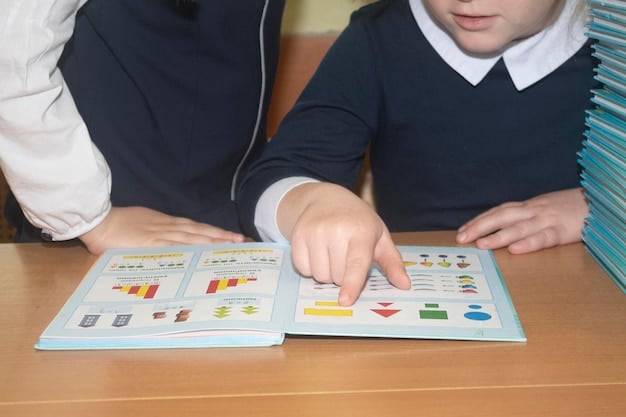Federal Policy Changes: Impact on Public and Private Education in the US

Federal policy changes on school vouchers significantly alter the landscape of education in the US, impacting funding, accessibility, and the overall structure of both public and private educational systems, raising questions about equity and quality.
The introduction of federal policy changes concerning school vouchers sparks considerable debate across the United States. Understanding the implications of these changes is crucial for parents, educators, and policymakers alike. This article delves into how these federal policy changes on school vouchers affect both public and private education sectors.
Understanding Federal School Voucher Programs
School voucher programs have been a topic of discussion in the U.S. education system for decades. Federally driven changes to these programs can have cascading effects on states, local districts, and individual families.
These programs essentially provide public funding that allows students to attend private schools, potentially altering the dynamics of resource allocation and educational access.
The Core Mechanics of School Vouchers
School vouchers, at their core, reallocate public education funds. Here’s a quick breakdown:
- Funding Source: Vouchers are typically funded by state or federal tax dollars.
- Recipient: Parents receive a voucher to use towards tuition at a private school of their choice.
- School Choice: The voucher aims to expand school choice, particularly for families in underperforming districts.

Whether these programs enhance educational outcomes and opportunities is a central question in the ongoing policy debate.
The Current Federal Policy Landscape
Federal involvement in school voucher programs has varied across administrations. Recent policy shifts have either amplified or curtailed federal support, depending on the prevailing educational priorities.
Understanding the current federal policy framework helps stakeholders anticipate future directions and potential consequences for local education systems.
Key Federal Legislation and Initiatives
Several federal laws and initiatives shape the school voucher landscape:
- Every Student Succeeds Act (ESSA): While ESSA primarily focuses on public schools, it indirectly affects voucher programs by influencing overall education funding and accountability measures.
- Opportunity Scholarships: Some federal proposals have advocated for tax credits that support private school scholarships, effectively acting as vouchers.
- Department of Education Guidance: The Department of Education’s stance and guidance play a crucial role in how states implement and manage voucher programs.
These policies intertwine to create a complex web of regulations and incentives that affect school choice and public education funding. The details are constantly changing, which is why this is so important.
Impact on Public Schools
One of the most discussed impacts of federal policy changes on school vouchers is their effect on public schools. Critics argue that vouchers divert crucial funding away from public institutions.
The financial implications and potential academic consequences for public school students are significant concerns that warrant careful consideration.
Funding Diversion and Resource Depletion
The diversion of funds from public to private schools through vouchers can strain public school budgets. As funding decreases, public schools may face challenges such as:
- Larger Class Sizes: Reduced funding can lead to fewer teachers, resulting in larger classes.
- Program Cuts: Public schools may need to eliminate extracurricular activities or specialized programs.
- Infrastructure Neglect: Limited resources can hinder necessary maintenance and upgrades to school facilities.
Potential Academic Consequences
The academic performance of students in public schools might also be affected. Some studies suggest that increased competition from private schools can push public schools to improve, but others show negative impacts due to resource constraints.
Further research is needed to fully understand these complex dynamics and the various policy decisions that come into play.
Impact on Private Schools
Federal policy changes also profoundly impact private schools. Vouchers can increase enrollment and provide financial stability, but they also introduce new regulations and accountability measures.
The balance between autonomy and compliance is a key consideration for private schools participating in voucher programs.

Increased Enrollment and Financial Stability
Vouchers can lead to higher enrollment in private schools, especially those catering to low-income families. This influx of students can result in:
- Expanded Programs: Private schools may be able to offer more diverse academic and extracurricular programs.
- Facility Improvements: Increased revenue can support upgrades to school infrastructure.
- Teacher Compensation: Private schools might be able to attract and retain high-quality teachers with better salaries.
Increased enrollment and financial security can also mean more opportunities for students attending the schools.
The Debate Around Equity and Access
A central point of contention in the school voucher debate is whether these programs promote or hinder equity and access to quality education.
Proponents argue that vouchers empower families, especially those from disadvantaged backgrounds, to choose better educational options. Critics, however, worry about the potential for exacerbating inequalities.
Arguments for Increased Equity
Supporters of vouchers argue that they level the playing field by:
- Providing Choice: Vouchers enable low-income families to access private schools they otherwise couldn’t afford.
- Promoting Competition: Increased competition can incentivize all schools to improve their quality.
Concerns About Exacerbating Inequalities
Critics raise concerns that vouchers can worsen existing inequalities by:
- Cream Skimming: Private schools might selectively enroll high-achieving or less challenging students, leaving public schools with a higher concentration of students with special needs.
- Limited Accessibility: Not all private schools accept vouchers, and those that do may have lengthy admissions processes. Transportation can also be a barrier.
Equity and access in education are critical considerations that must be addressed.
The Future of Federal Voucher Policies
The future of federal involvement in school voucher programs remains uncertain, heavily influenced by political shifts and evolving educational priorities.
Understanding potential future scenarios can help stakeholders prepare for upcoming changes and advocate for policies that best serve their communities.
Potential Policy Shifts Under Different Administrations
Changes in presidential administrations can lead to significant policy shifts. For example:
- Increased Support: An administration prioritizing school choice might push for expanded voucher programs and tax credits for private schooling.
- Reduced Support: Conversely, an administration focused on strengthening public education might curtail federal support for vouchers and prioritize funding for public schools.
Keeping abreast of these trends is essential for informed decision-making and effective advocacy.
Federal policies regarding school vouchers are dynamic and multifaceted, requiring ongoing evaluation and adaptation to meet the evolving needs of students and communities.
| Key Aspect | Brief Description |
|---|---|
| 🏫 School Vouchers | Public funds for private school tuition, expanding parental choice. |
| 💸 Funding Impact | Affects resource allocation between public and private education sectors. |
| ⚖️ Equity Debate | Concerns arise over potential exacerbation of educational inequalities. |
| 🔮 Future Policies | Policy shifts contingent on political administrations and educational priorities. |
Frequently Asked Questions
▼
School vouchers are government-funded certificates that parents can use to pay for tuition at private schools. They aim to give families more choice in their children’s education, especially those in underperforming districts.
▼
Federal policies can significantly influence voucher programs through funding allocations, regulatory guidance, and the promotion of specific educational initiatives. These policies can either expand or restrict the scope and availability of vouchers.
▼
Potential benefits include increased school choice for parents, improved educational outcomes for voucher recipients, and greater competition among schools, which can lead to enhanced quality and innovation in education.
▼
Criticisms often focus on the potential diversion of funds from public schools, the possibility of increased segregation, and concerns that private schools may not be held to the same accountability standards as public schools.
▼
Parents can stay informed by following updates from the Department of Education, monitoring news from reputable education organizations, and engaging with local school boards and parent-teacher associations to discuss policy impacts.
Conclusion
In conclusion, federal policy changes on school vouchers represent a complex and continuously evolving aspect of the American education system. While vouchers aim to provide families with expanded educational choices and promote competition among schools, they also raise critical questions about equity, resource allocation, and the overall impact on both public and private education sectors. Staying informed and engaged in the policy debate is essential for all stakeholders to ensure that the needs of students and communities are effectively addressed.





